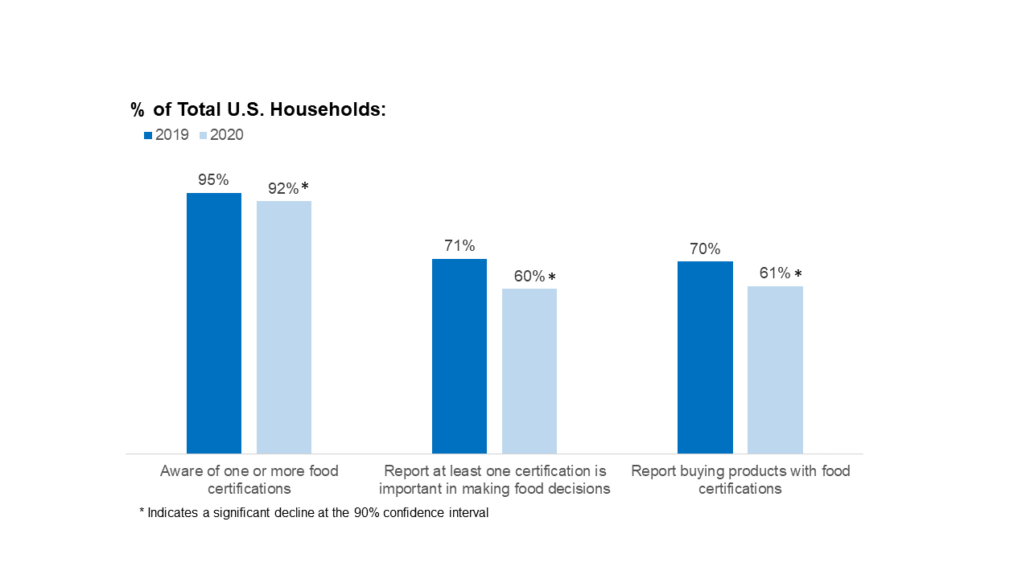In November 2020 Linkage Research completed its annual consumer survey of food certifications and the latest data indicates that the pandemic induced impact on shopping habits has impacted awareness and purchase of food goods with certifications. Compared to November 2019, awareness of one or more food certifications is down 3 points and households that report buying a good with a food certification is down 9 points.
It is not surprising that the pandemic has influenced food certification purchases. Out-of-stock situations, a shift to center-store comfort foods, and the significant growth of grocery shopping online have all had an impact on which foods and brands consumers choose. Despite this change, 6 in 10 households still report buying goods with certifications, making these claims an important part of food product sourcing and design. As certifiers and manufacturers look to the future, this blog provides some key insights to consider around food certifications.

Younger, Higher Income Shoppers Who Buy Groceries Online are Driving Food Certifications
Like 2019, our survey shows that buyers of certified goods skew both younger and more affluent. These households have both the interest and the means to buy certified goods that are often priced at a premium. But one nuance we are seeing in the 2020 data is these buyers are twice as likely to have shifted their grocery shopping online than non-buyers of certified goods as a result of the pandemic. Shopping online creates two opportunities to drive goods with food certifications: the first is the ability for buyers to search for specific claims and, second, is the opportunity to provide more visual real estate to highlight certifications. In the online store environment, a certification can be called out in the product description and the certification icon can pulled out next to the package making it much more prominent than the in-store environment where certifications may be relegated to the back of package due to space limitations.
Demand Among Households that Buy Certified Goods is Up Significantly
While the data shows that the total number of households buying certified products is down, overall demand for certified goods among households that do buy is up significantly. Three-quarters (74%) of households that purchase certified goods report that their purchasing of at least one certification they value has increased as a result of the pandemic. This shows how important the transparency of a third-party certification is to these households, especially during a time when the pandemic has put more focus on their health and immunity.
The Most Appealing Certifications Continue to Surround Natural Sourcing
The top certifications sought out by consumers have remained consistent year-over-year. Topping the list again in 2020 are certifications that give consumers peace of mind that their food is natural and safe for their health, including USDA Organic, Non-GMO Project, and Certified Naturally Grown. These certifications speak to the transparency consumers, driven by younger generations, demand from food suppliers and manufacturers. And 60% of consumers who are aware of these certifications are willing to pay a premium for products with them. This makes these top certifications an important consideration for manufacturers who want to capture young and affluent households with their products.
Implications for the Future of Food Certifications
As we look forward toward a post-pandemic world, we believe certifiers and manufacturers can learn and capitalize on a few trends we have seen in 2020. The first is that there is a dedicated base of younger consumers who prioritize certifications. Manufacturers who want to appeal to these consumers will benefit from understanding their needs and delivering on those certifications that matter most to their specific target buyer. The second is to ensure that online product messaging is optimized to capture the buyer looking for specific certifications. This includes designing pages with the right terms for search and prominently displaying the certification logo and text on the product page. And finally, manufacturers should not forget or abandon certifications in the in-store environment. Although there has been a shift to online shopping, most consumers still shop bricks and mortar. Brands that want to stand out need to ensure that the certification claim and logo are prominently displayed on front of package.
All data reported in this article is sourced from a large-scale Internet-based study with 1,000 households conducted in November 2020 by Linkage Research & Consulting. The study was representative of the US based on geography, gender, age, race, and income. For more insights on food certifications, Linkage Research offers a comprehensive report on food certifications which can be found HERE.

